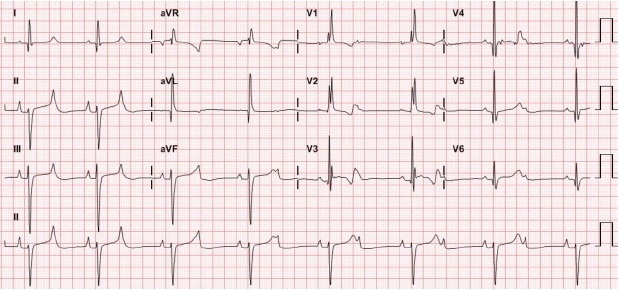Kosin Med J.
2019 Jun;34(1):47-51. 10.7180/kmj.2019.34.1.47.
Lethal Cardiac Complications in a Long-Term Survivor of Spinal Muscular Atrophy Type 1
- Affiliations
-
- 1Department of Pediatrics, Pusan National University Hospital, Biomedical Research Institute of Pusan National University Hospital, Busan, Korea. mjchomd@gmail.com
- KMID: 2451775
- DOI: http://doi.org/10.7180/kmj.2019.34.1.47
Abstract
- Spinal muscular atrophy (SMA) is a rare neuromuscular disease characterized by degeneration of the anterior horn cells of the spinal cord and motor nuclei in the lower brainstem, resulting in hypotonia, progressive proximal muscle weakness, paralysis, and progressive respiratory insufficiency. We report the case of a 6-year-old girl diagnosed with spinal muscular atrophy type 1 (Werdnig-Hoffman disease) who has been treated at home with non-invasive ventilation (assist-control mode with a back-up respiratory rate of 26 per minute). She presented with an atrioventricular block and atrial fibrillation, as well as paroxysmal fluctuation of blood pressure and heart rate indicating autonomic dysfunction. Although it is known that patients with spinal muscular atrophy type 1 do not generally demonstrate cardiac problems, it can be concluded based on findings in our case that long-term survivors with spinal muscular atrophy type 1 may develop cardiac rhythm disturbances. We therefore recommend that the possibility of cardiac complications and autonomic dysfunction should be borne in mind in the management of such patients.
MeSH Terms
-
Anterior Horn Cells
Atrial Fibrillation
Atrioventricular Block
Blood Pressure
Brain Stem
Child
Female
Heart Rate
Humans
Muscle Hypotonia
Muscle Weakness
Muscular Atrophy
Muscular Atrophy, Spinal*
Neuromuscular Diseases
Noninvasive Ventilation
Paralysis
Primary Dysautonomias
Respiratory Insufficiency
Respiratory Rate
Spinal Cord
Survivors*
Figure
Reference
-
1. Kolb SJ, Kissel JT. Spinal Muscular Atrophy. Neurol Clin. 2015; 33:831–846.
Article2. Butchbach ME. Copy Number Variations in the Survival Motor Neuron Genes: Implications for Spinal Muscular Atrophy and Other Neurodegenerative Diseases. Front Mol Biosci. 2016; 3:7.
Article3. Nicole S, Diaz CC, Frugier T, Melki J. Spinal muscular atrophy: recent advances and future prospects. Muscle Nerve. 2002; 26:4–13.
Article4. Oskoui M, Levy G, Garland CJ, Gray JM, O'Hagen J, De Vivo DC, et al. The changing natural history of spinal muscular atrophy type 1. Neurology. 2007; 69:1931–1936.
Article5. Chung BH, Wong VC, Ip P. Spinal muscular atrophy: survival pattern and functional status. Pediatrics. 2004; 114:e548–e553.
Article6. Elkohen M, Vaksmann G, Elkohen MR, Francart C, Foucher C, Rey C. [Cardiac involvement in Kugelberg-Welander disease. A prospective study of 8 cases]. Arch Mal Coeur Vaiss. 1996; 89:611–617.7. Takahashi N, Shimada T, Ishibashi Y, Sugamori T, Hirano Y, Oyake N, et al. Cardiac involvement in Kugelberg-Welander disease: a case report and review. Am J Med Sci. 2006; 332:354–356.
Article8. Rudnik-Schöneborn S, Heller R, Berg C, Betzler C, Grimm T, Eggermann T, et al. Congenital heart disease is a feature of severe infantile spinal muscular atrophy. J Med Genet. 2008; 45:635–638.
Article9. Bach JR. Medical considerations of long-term survival of Werdnig-Hoffmann disease. Am J Phys Med Rehabil. 2007; 86:349–355.
Article10. Hachiya Y, Arai H, Hayashi M, Kumada S, Furushima W, Ohtsuka E, et al. Autonomic dysfunction in cases of spinal muscular atrophy type 1 with long survival. Brain Dev. 2005; 27:574–578.
Article
- Full Text Links
- Actions
-
Cited
- CITED
-
- Close
- Share
- Similar articles
-
- A Case of Type III Proximal Spinal Muscular Atrophy Distinguished from Distal Spinal Muscular Atrophy: A case report
- Spinal Muscular Atrophy Type 2 in Siblings
- Camptocormia Due to Selective Paraspinal Muscle Atrophy
- A Case of Spinal Muscular Atrophy with Hypertrophy of Calf-Muscles
- Bilateral Corneal Opacities with Galactokinase Deficiency and Spinal Muscular Atrophy



